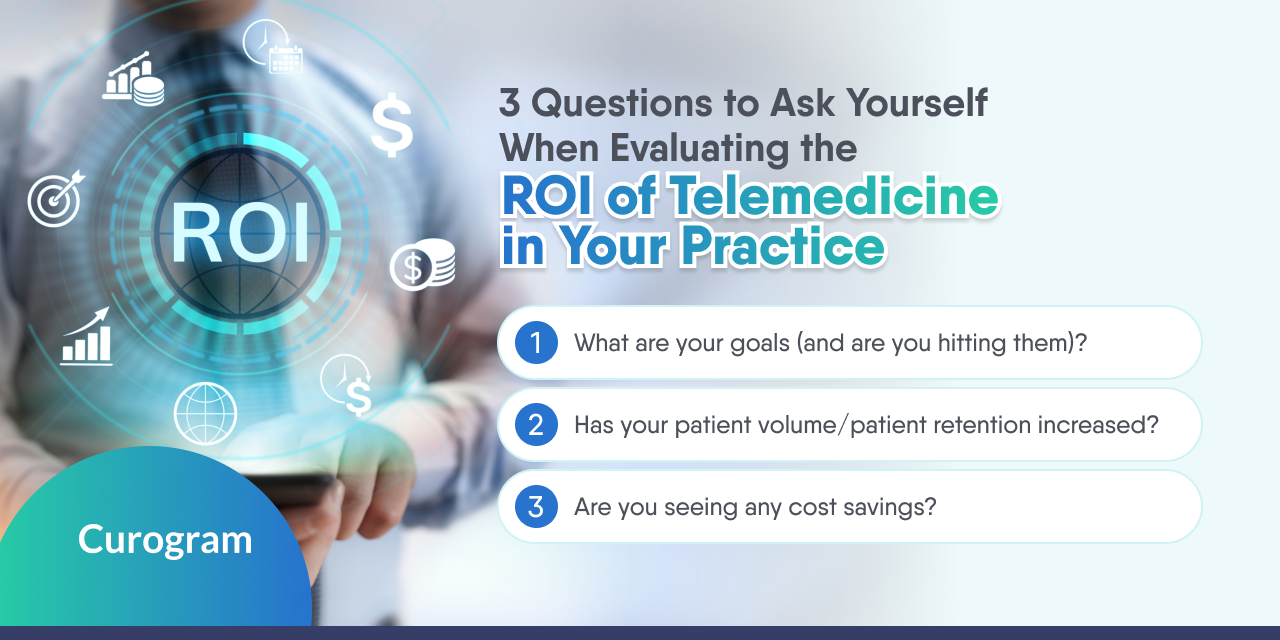How Does Telemedicine Work?
Originally, telemedicine's purpose was to provide primary care to patients from rural areas who needed medical attention but had limited access to...

You now understand how telemedicine or telehealth works and its rules and regulations, especially the Health Insurance Portability and Accountability Act (HIPAA). It’s time to look at your return of investment (ROI) and measure the probability of your return on your investment in a telemedicine program.
Having a telemedicine program requires time, analysis, and resources as healthcare providers typically make upfront investments in technology, staff training, and other considerations. While insurance companies expand coverage and reimbursement of telehealth services, you must also look beyond reimbursement and find out if you are getting your money’s worth on your remote care delivery arrangement.
ROI can take many forms. Here are essential questions to ask when calculating your telemedicine ROI
Healthcare organizations and providers have different profiles that significantly impact their telemedicine ROI. When calculating ROI, you should note that its scheme isn’t one-size-fits-all. Healthcare organizations and medical practices are different from one another, which means telemedicine program ROI varies widely and depends on the following:
Since healthcare providers and organizations have different characteristics, their ROIs are fundamentally diverse. With this in mind, you can assess the return you are getting from your investment by asking the right questions and looking at the most crucial parts of your telemedicine program.
Virtual care investments are highly contingent on the objectives and goals of your telehealth capabilities. Each remote care setup is unique as it depends on the characteristics of your organization or practice. Set realistic goals for your remote healthcare delivery journey based on the size and nature of your organization, clinical capacity, and payment model.
If your practice is new, you must test the waters. Schedule your office hours based on the flow of appointment bookings. Determine the number of patients you could accommodate for virtual visits per day. You can measure ROI by examining how many patients your practice can engage via telehealth. If your goal is to achieve a 25% boost of new patients, but you eventually reach 30%, you see a good ROI.
Ultimately, your patients will shape the goals of your telemedicine program. Stick to what your patients want and need when it comes to telemedicine. Don’t go overboard to avoid wasting time and money.
Appointment volume and patient retention numbers are crucial in every remote care program. You can measure ROI by looking at the number of appointment bookings and patient retention your practice has received since you started offering telehealth services. Medical practices offer similar telehealth services at the same rates, but when it comes to patient volume and retention, one practice may be more successful than the other. A crucial factor in this distinction is patient retention.
Patients are the foundation of every medical practice. That is why they substantially contribute when calculating ROI on your telemedicine program. Gaining and keeping patients generates higher revenue, so your remote care program must focus on the cycle of getting and retaining patients. One way to do this is to simplify and improve patient appointment scheduling.
You can use text messaging as part of your scheduling system and send appointment reminders. Your telemedicine program must use a 2-way, HIPAA-compliant text messaging system that encourages more patients to book virtual consultations with your practice. With texting, your patients can easily schedule and reschedule their appointments, and you can notify them with appointment reminders to prevent patient no-shows or cancellations. That improves ROI and can help grow your patient numbers.
Remote care technology is changing the things medical staff do manually, such as scheduling appointments and obtaining health records. A telemedicine program must allow your practice to streamline its workflow, from digitizing patient forms to setting up virtual meetings. It’s clear that telehealth cuts unnecessary administrative costs without jeopardizing service standards, so make sure you achieve this with your setup.
A vital factor in assessing ROI is the reduction of your practice overhead, given that the cost of a virtual visit is typically way less than an in-person consultation. The cost reduction comes from using telehealth communication platforms such as video conferencing and text messaging and requiring fewer resources than an in-office appointment. Moreover, telemedicine automates time-consuming clinical tasks and digitizes records so you won’t spend money hiring more staff and constantly purchasing papers, printers, ink, etc.
When optimized correctly, your telemedicine program reduces administrative expenses and staff workload while increasing revenue. That means you are spending less while gaining more, increasing ROI.
If you are wondering if you need cutting-edge technology for your telemedicine program, the answer is no. You only need the most common technology available today, the hardware and software. Selecting telehealth software is crucial because the system must adhere to HIPAA rules and regulations.
Meanwhile, choosing hardware is easy; healthcare providers and patients will likely use the technology in their everyday lives: desktop computers, laptops, tablets, and smartphones. You don’t need to purchase the most expensive software and hardware; you only need the most reliable because there are other aspects that you have to invest in, including:
Healthcare providers like you must assess the ROI of their telehealth program by evaluating its impact on the organization, improvement in revenue, and technology’s effect on health outcomes. By tailoring these key factors when calculating ROI on your telemedicine program, you have a more precise understanding of how your program affects your bottom line.


Originally, telemedicine's purpose was to provide primary care to patients from rural areas who needed medical attention but had limited access to...

California is a state with a long history of supporting telemedicine and telehealth as legitimate ways to deliver medical care to patients remotely. ...

While rural residents enjoy the many benefits of living outside of the city, one of the main downsides of living in rural areas is access to...